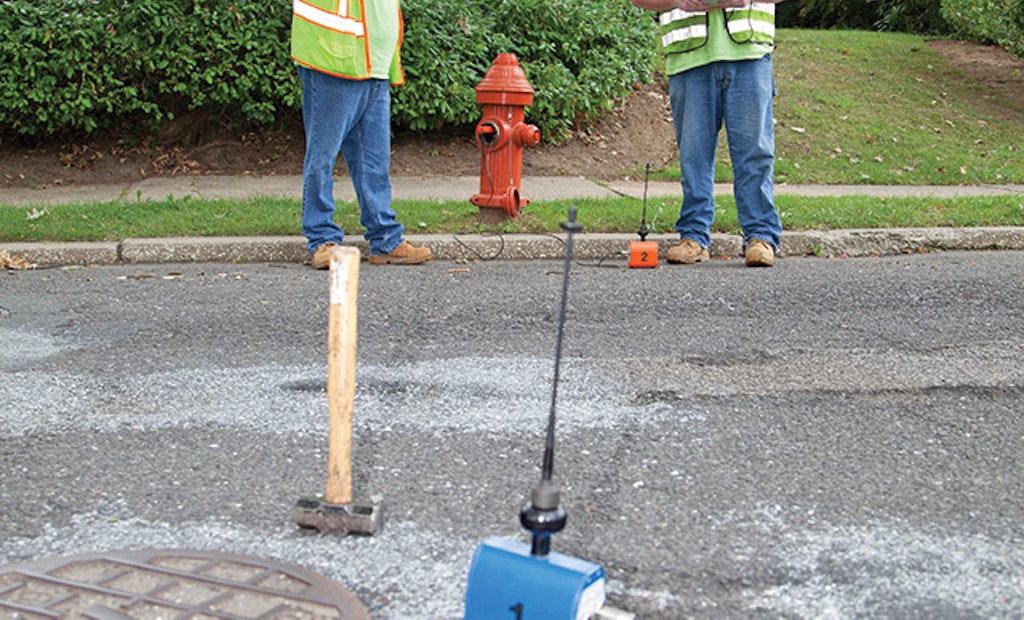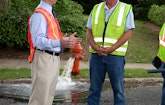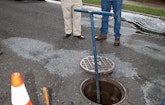
Interested in Location/Detection?
Get Location/Detection articles, news and videos right in your inbox! Sign up now.
Location/Detection + Get AlertsPhiladelphia is one of the oldest cities in the country but the Philadelphia Water Department's (PWD) approach to stormwater management, sewer overflow and water system leak detection represent a significant evolution in the methods in which the city manages its infrastructure. At the heart of these initiatives is a passion for effective asset management and an emphasis on the bottom line.
Sewer and stormwater and management
The City of Philadelphia's sewer and stormwater system is managed under the guidance of its Green City, Clean Waters initiative, which treats the region and its systems holistically. Composed of both traditional grey infrastructure and green initiatives, the plan goes back to 1999 and was based on a concept developed by current water commissioner Howard Neukrug.
"He sketched out the plan on a napkin, which he still has in his office," says Christopher Crockett, deputy commissioner of Planning & Environmental Services with the PWD. "He outlined a $1 billion green infrastructure program that leveraged our current grey infrastructure. The idea passed a triple bottom line analysis that assessed the environmental, social and economic benefits of the plan. It also seemed to coincide with a time where development along the Delaware and Schuylkill rivers was taking off and we were seeing a number of changes in the social development of the city. It was the right idea at the right time and we got to work on it."
The PWD received considerable guidance and encouragement from the U.S. Environmental Protection Agency and the Pennsylvania Department of Environmental Protection in officially establishing the plan in 2004.
Working with regulators
"It's one of the first large green infrastructure programs in the country and the regulators worked with us to demonstrate how it could work and meet the targets of environmental regulations," says Crockett. "They clearly wanted it to succeed as much as we did."
The department operates 1,827 miles of combined sewers, 749 miles of sanitary sewers, and 720 miles of stormwater conduit, with some of the infrastructure dating back to the early 1800s. The PWD targets a 120-year replacement rate for sewer infrastructure.
"Some of the system is lined with bricks and the work of the craftspeople is so good you'd think it could last another few centuries," says Crockett. "In many cases, the damage inflicted on the system results from normal city activity, but it's holding up better than some of the projects from the 1950s when the work became more mechanized."
The projects under the initiative are diverse, encompassing both system expansion and improvement, and source reduction. Replacement of eight miles of sewer mains per year and concrete relining of other sewer infrastructure by contractors, for example, falls under the plan. Under the ongoing Philadelphia Sewer Assessment Program, the system is inspected on an ongoing basis using closed circuit television cameras operated by in-house crews.
Major capital investments
Major capital projects under the initiative include a $200-million, 25-year plan to expand its Northeast Water Pollution Control Plant by 215 mgd to 650 mgd in wet weather. The PWD is also currently building a $47-million sanitary sewer overflow in Manayunk along the Schuylkill River.
"This is a big project about the size of a football field in a downtown business district with a lot of restaurants and traffic congestion," says Crockett. "We had to remove a recreation center which will be rebuilt on top of the project when it's finished, but we simply had to face the fact that this was the only location where it could be built."
The PWD also negotiates with satellite clients who depend on the department's wastewater treatment plant to reduce inputs into the system.
"We're partnering with them to reduce their peak flows to something more manageable, in part by helping them find solutions to their own I&I problems," he says.
Green initiatives
The PWD is also pursuing specifically green initiatives as part of its program, such as the use of porous asphalt for street paving.
"There are a lot of win-wins with projects like this," says Crockett. "Porous asphalt allows precipitation to drain into the ground underneath the pavement instead of entering the stormwater system. We are working to demonstrate to the streets department that porous asphalt reduces ponding and freeze/thaw damage while improving snow removal issues."
Initiatives such as this require considerable cross-department communication and planning. For example, last year, the city's transit system created its first green roof bus stop, replete with a rooftop garden that diverts water from the stormwater system.
"We love to find these chocolate and peanut butter moments," says Crockett. "Maybe there's a project that's on hold, but the PWD might be the catalyst that moves it along, or allows another project to piggyback onto it. You won't hit a home run with every pitch, but you may keep moving that project closer to completion."
Crockett says that some sewer and stormwater projects are considered more acceptable to the public when they're combined with an obvious improvement to above-ground infrastructure.
"If you piggyback a stormwater project onto one involving the installation of street furniture, new tree plantings, or a park with a permeable asphalt basketball court, they tend to see it as a quality of life improvement," he says.
Crockett's advice to other jurisdictions pursuing green infrastructure solutions is to do what works best, not necessarily assume that green infrastructure represents the best solution for each project.
"Maybe in your area grey is best or green is best," he says. "I'd describe our system as grey with green on top. However, if the best solution for one city is a tunnel, then build a tunnel. It depends on your needs and situation. Use the Goldilocks principle to create the mix that's right for your situation — not too hot, not too cold, but just right."
Water system leak detection
The PWD supplies treated water not only to its own citizens but also to communities in the city's suburbs. A critical component of that delivery is controlling water loss and leaks and auditing those results with an eye to the bottom line.
The city maintains 3,159 miles of water mains ranging in diameter from 6 to 93 inches. The average age of mains is 68 years, although the city also claims the oldest active piping in the country, dating back to 1822. About 65 percent of mains are made of cast iron, and 25 percent are newer mains made of ductile iron. Other materials account for 10 percent.
The department fields a 20-person team dedicated to detecting water main leaks. The team covers approximately 1,000 miles of line each year in leak listening surveys, so that the system is scanned, on average, once every three years.
Extensive asset records
"We believe that this is just about right for our system," says George Kunkel, water efficiency program manager with the PWD. "We've been working to that schedule for more than 30 years. We've been consistently maintaining asset records and our leak detection tracking data, costs and savings goes back to the late 1970s. We've got a good basis for a cost-benefit argument supporting that schedule."
Areas of the city prone to leaks receive more frequent attention, up to once every 18 months, while newer infrastructure lags slightly at four years.
"We field two or three crews during the day shift, and two during the night shift, from 10 p.m. to 6 a.m. when the city is quieter and we can more easily detect leaks in noisier areas using acoustic equipment," says Kunkel. "They perform general sounding using acoustic listening devices and when they have a suspicion of where the leak is, they pinpoint it using a leak correlator. The team will do further checking manually and mark the location with spray paint, then refer the location for repair."
Acoustic leak detection works best in smaller mains located close to the surface. For larger diameter transmission mains buried deeper, the department has conducted a five-year pilot study using Sahara, a technology service offered by Pure Technologies. Sahara employs an acoustic sensor outfitted with a parachute that's inserted into a tap on pipelines 16 inches in diameter or larger. Tethered outside, the device is carried through the main along with the water flow, as a human operator outfitted with a locating tool shadows its passage on the surface.
Sahara has located 76 leaks in more than 36 miles of mains since 2007. Some of those leaks were found in challenging locations that included mains running under a creek, beneath wooded parkland and below an interstate highway.
All told, the PWD repaired 954 water main breaks and over 2,500 leaks in 2011.
District metering study
The PWD has also conducted a three-year pilot district metering study conducted from 2007 to 2010 through the Water Research Foundation. Under the study, a specific district in the water system was isolated through engineered valving while water flow was maintained and tracked through a single supply pipe.
"It's a common technique internationally, particularly in the UK," says Kunkel. "The idea is intuitive and one of those things where you ask yourself why you didn't think of it sooner. We typically see water consumption falling to a minimum and leveling off in the wee hours of the morning. If you collect consumption data over weeks and suddenly see a rise in demand, we can determine whether that demand on the system is related to consumption, or emerging leakage."
The study not only helped to isolate leaks in this specific district metered area, but also allowed the department to moderate historic pressure levels through the use of pressure reducing valves, to achieve a further degree of leakage control.
"Water pressure influences the rate of leakage," says Kunkel. "In a pinhole leak, a much higher leakage rate occurs at 150 psi of pressure compared to 50 psi of pressure. Pressure management targets the weeps and seeps at pipe joints and fittings that are very pressure-dependent. International studies have shown that, over time, pressure controls also lessen stress on the overall distribution infrastructure, leading to fewer main breaks and extended system life."
The city also continues to upgrade customer meters, verify the accuracy of system flowmeters, and categorize all unbilled treated water.
Quantifying success
The PWD has annually quantified the results of its water loss control program for the period from 2000 to 2011 and uses free software supplied by the American Water Works Association (AWWA). The reports demonstrated that program efforts showed a positive economic benefit of more than $16 million over that time.
The PWD is also using CapPlan Water software from Innovyze to crunch a century of data on pipe materials, locations, geographic features and age of infrastructure. Using that information, CapPlan will provide the department with probability and consequence tools to execute informed infrastructure planning with limited financial resources.
Kunkel's advice to any utility regarding leakage management: "All water utilities should conduct leak detection at a time interval that is appropriate for them. No matter whether leak detection is conducted every three years or every five years, it's important to set up tracking procedures to determine the value of that program and how it impacts the bottom line. The AWWA provides excellent guidance on how to collect and assess leak detection data."
















